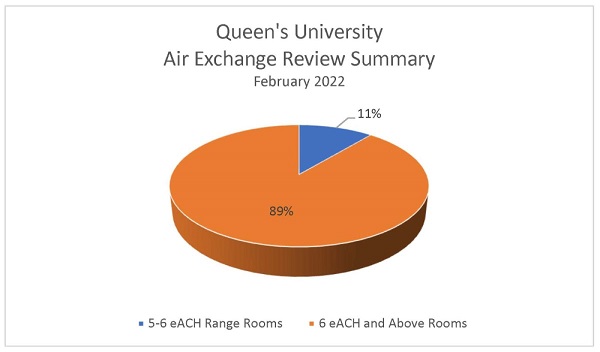COVID-19 has not changed code or regulatory requirements for workplaces; nevertheless Queen's University is following industry recommendations of the Epidemic Task Force of the American Society of Heating, Refrigeration and Air-conditioning Engineers (ASHRAE) as well as public health practices (Heating, Ventilation and Air Conditioning (HVAC) Systems in Buildings and COVID-19 (publichealthontario.ca)) to maintain and operate ventilation systems for buildings across campus. Queen's ventilation management measures have been discussed with and endorsed by our public health experts.
Queen’s ventilation management measures include:
- System Commissioning: Inspecting heating, ventilation and air conditioning (HVAC) systems to confirm they are operating at their full capacity and in good working order
- Filters: MERV 13 and 14 filters are used where they can be physically accommodated. In HVAC systems that are not designed to accommodate a higher filtration system it is not advantageous to increase the MERV rating as the airflow will be restricted and the fans will deliver less air to the space, reducing the air changes per hour. New air filters are installed on a regular schedule to ensure all systems have clean filters
- Maximizing Fresh Air: Extending the fan run time of ventilation control systems an additional two hours before and after the scheduled use period of the building to further flush the facilities and increase the number of daily air exchanges within. In addition, during occupied hours, outdoor air supply will be increased to the highest extent possible within the equipment’s capacity to heat, cool, and humidify
- Supplemental Air Purification: High-Efficiency Particulate Air (HEPA) air purification units are being used in classrooms with measured or calculated eACH below 5.
- Operable Windows: Ensuring classroom windows are operable to allow for fresh air intake where feasible and weather permitting
The University uses equivalent air changes per hour (eACH) as a measure of the ventilation in classrooms. Air changes per hour indicates the number of times in an hour that the entire volume of the room is changed by the ventilation equipment. HEPA air filters have been used to achieve a minimum of 3 eACH in all classrooms and teaching labs in the Fall of 2021. This original target of at least 3 eACH was based on a Harvard study that indicates 3 eACH is a minimum. The study notes that 4 to 5 eACH is good and 5 to 6 is excellent. With the prevalence of the Omicron variant towards the end of 2021, the University has now moved to a new minimum of 5 eACH and has added HEPA filters to all classrooms and teaching labs where the measured or calculated eACH was below 5.
The university undertook an analysis of the eACH in 579 teaching spaces on campus. These were calculated measures using building design drawings and room designs. To expedite the analysis, classrooms in buildings with modern mechanical ventilation systems (newer buildings) were not individually analysed as the systems would have eACHs greater than 6, as indicated on the list. The university also engaged an external consultant to independently verify the eACHs for a sample of classrooms, shown as measured eACH in the list below.
As mentioned above, the University has now moved to a new minimum of 5 eACH, and has recently added HEPA filters to all classrooms and teaching labs where the measured or calculated eACH was below 5. In February 2022, the university engaged an external consultant to measure all rooms where new HEPA filters were added to verify that the eACH is above 5.
All classrooms, teaching labs and libraries now have equivalent air changes per hour (eACH) of 5 or above.
Below are two PDF files, one for classrooms and teaching labs, and one for Libraries. These lists are updated as of February 25, 2022. These lists note the eACH, whether it is calculated (by Facilities engineers), measured (by an external consultant), or above 6 as it is in a modern building. The lists also indicate if there are HEPA filters in the room.

 Find us
Find us